These groups of drugs affect clot formation and resolution by hindering different steps in clotting formation which include altering the formation of platelet plug (antiplatelet drugs), interfering the clotting cascade and thrombin formation (anticoagulant drugs), and stimulating the plasmin system to break down the formed clot (thrombolytic agents).
Table of Contents
- Coagulation Drugs: Generic and Brand Names
- Disease Spotlight: Thromboembolic and Hemorrhagic Disorders
- Antiplatelet Agents
- Anticoagulants
- Thrombolytic Agents
- Practice Quiz: Drugs Affecting Coagulation
- Recommended Resources
- See Also
- References and Sources
Coagulation Drugs: Generic and Brand Names
Here is a table of commonly encountered antiplatelet, anticoagulant, and thrombolytic agents, their generic names, and brand names:
- Antiplatelet Agents
- acetylsalicylic acid (Aspirin, Aspro Clear, Disprin, Bayer Aspirin)
- cilostazol (Pletal)
- dipyridamole (Persantine)
- tirofiban (Aggrastat)
- Anticoagulants
- warfarin (Coumadin)
- dabigatran (Pradaxa)
- rivaroxaban (Xarelto)
- Thrombolytic Agents
- alteplase (Activase)
- reteplase (Retavase)
- tenecteplase (TNKase)
- urokinase (Abbokinase)
- Low-molecular weight Heparins
- dalteparin (Fragmin)
- enoxaparin (Lovenox)
- tinzaparin (Innohep)
- Anticoagulant Adjunctive Therapy
- lepirudin (Refludan)
- protamine sulfate
- vitamin K
- Hemorrheologic Agent
- pentoxifylline (Trental)
Disease Spotlight: Thromboembolic and Hemorrhagic Disorders
Disorders that directly affect coagulation process are divided into two main categories: 1) thromboembolic disorders, which involve overproduction of clots; and 2) hemorrhagic disorders, which is characterized by ineffective clotting process leading to excessive bleeding.
Thromboembolic disorders include medical conditions (e.g. CAD) which involve overproduction of clots which result into decreased blood flow and total vessel occlusion. Manifestations include hypoxia, anoxia, and even necrosis. These disorders are treated by drugs that interfere with normal coagulation process to prevent formation of clots.
On the other hand, less common hemorrhagic disorders is characterized by excessive bleeding. These are treated by drugs that promote the clotting process. Some of these conditions include:
- Hemophilia: characterized by genetic lack of clotting factors
- Liver disease: characterized by non-production of proteins and clotting factors necessary for clot formation
- Bone marrow disorders: characterized by insufficient quantity of platelets rendering them ineffective
Antiplatelet Agents
- This drug class exerts its action by decreasing the responsiveness of platelets to stimuli that cause it to clump or aggregate. Through this, formation of platelet plug is decreased.
Therapeutic Action
- By blocking receptor sites on the platelet membrane, platelet adhesion and aggregation is inhibited.
- Also, platelet-platelet interaction as well as interaction of platelets to clotting chemicals are prevented.
Indications
- Primarily indicated for cardiovascular diseases that have potential for development of vessel occlusion.
- Other indications include maintenance of arterial and venous grafts, preventing cerebrovascular occlusion, and including them as adjunct to thrombolytic therapy for treatment of myocardial infarction.
- One drug, anagrelide, blocks the production of platelets in the bone marrow.
Children
- Only heparin and warfarin are indicated for children but these drugs alone require careful dose calculation.
Adults
- Caution is particularly important to prevent injury (e.g. using electric razor and soft-bristled toothbrush).
- It is also important that adults are educated on what to do should bleeding occurs (e.g. applying firm pressure) as well as what signs of bleeding should be watched out for.
- Other drugs taken should be documented because there are a lot of drug interactions with these drug class. It should also be emphasized that periodic blood tests is expected to monitor the effect of therapy.
Pregnant women
- For pregnant women, it is not advisable unless the benefit to the mother would clearly outweigh the risk for the fetus. On the other hand, for lactating women, it is generally inadvisable.
Older adults
- Are more susceptible to drug toxicity and drug-to-drug interactions.
- Careful monitoring of liver and kidney function is important for this age group.
- Therapy is always started at the lowest level possible and adjusted accordingly.
Pharmacokinetics
| Route | Onset | Peak | Duration |
| Oral | 5-30 min | 0.25-2 h | 3-6 h |
| T1/2: 15 min – 12 h Metabolism: liver Excretion: bile |
Contraindications and Cautions
- Allergy to antiplatelet agents. Prevent severe hypersensitivity reactions.
- Known bleeding disorder. Increased risk of excessive blood loss
- Recent surgery. Increased risk of bleeding in unhealed blood vessels
- Closed head injuries. Increased risk of bleeding in injured blood vessels of the brain
- History of thrombocytopenia. Anagrelide decreased bone marrow production of platelets.
- Pregnancy, lactation. Generally inadvisable because of potential adverse effects to fetus or neonate
Adverse Effects
- CNS: headache, dizziness, weakness
- GI: GI distress, nausea
- Skin: skin rash
- Hema: bleeding (oftenly occurs while brushing the teeth)
Interactions
- Increased risk of bleeding if combined with another drug that affects blood clotting.
Nursing Considerations
Here are important nursing considerations when administering antiplatelet agents:
Nursing Assessment
These are the important things the nurse should include in conducting assessment, history taking, and examination:
- Assess for the mentioned contraindications to this drug (e.g. hypersensitivity, acute liver disease, pregnancy etc.) to prevent potential adverse effects.
- Conduct thorough physical assessment before beginning drug therapy to establish baseline status, determine effectivity of therapy, and evaluate potential adverse effects.
- Obtain baseline status for complete blood count and clotting studies to determine any potential adverse effects.
Nursing Diagnoses
Here are some of the nursing diagnoses that can be formulated in the use of this drug for therapy:
- Disturbed sensory perception related to CNS effects
- Acute pain related to CNS and GI effects
- Risk for injury related to CNS effects and bleeding tendencies
Implementation with Rationale
These are vital nursing interventions done in patients who are taking antiplatelet agents:
- Administer drug with meals to relieve GI upset.
- Provide comfort measures for headache because pain due to headache may decrease patient compliance to treatment regimen.
- Educate patient on ways to promote safety like using electric razor, soft-bristled toothbrush, and cautious movement because any injury at this point can precipitate bleeding.
- Educate patient on drug therapy including drug name, its indication, and adverse effects to watch out for to enhance patient understanding on drug therapy and thereby promote adherence to drug regimen.
Evaluation
Here are aspects of care that should be evaluated to determine effectiveness of drug therapy:
- Monitor patient response to therapy (e.g. increased bleeding time, prevention of occlusive events).
- Monitor for adverse effects (e.g. bleeding, headache, GI upset).
- Evaluate patient understanding on drug therapy by asking patient to name the drug, its indication, and adverse effects to watch for.
- Monitor patient compliance to drug therapy.
Anticoagulants
- By interfering with clotting cascade and thrombin formation, anticoagulants are able to interfere with the normal clotting process.
Therapeutic Action
- Warfarin, an oral agent in this class, reduces Vitamin K-dependent clotting factors. As a result, clotting process is prolonged.
- Two new oral agents, dabigatran and rivaroxaban, directly inhibits thrombin (last step in clotting process) and factor Xa, respectively.
- Heparin and antithrombin block formation of thrombin from prothrombin.
Indications
- Among the many indications for this drug class include: stroke and systemic emboli risk reduction, nonvalvular atrial fibrillation, and deep vein thrombosis.
- Heparin is used for prevention of blood clots in blood samples, dialysis, and venous tubing. It also does not enter breastmilk so it is the anticoagulant of choice for lactating women.
- Antithrombin is a naturally-occurring anticoagulant and is a natural safety feature in the clotting system.
Children
- Only heparin and warfarin are indicated for children but these drugs alone require careful dose calculation.
Adults
- Caution is particularly important to prevent injury (e.g. using electric razor and soft-bristled toothbrush).
- It is also important that adults are educated on what to do should bleeding occurs (e.g. applying firm pressure) as well as what signs of bleeding should be watched out for.
- Other drugs taken should be documented because there are a lot of drug interactions with these drug class. It should also be emphasized that periodic blood tests is expected to monitor the effect of therapy.
Pregnant women
- For pregnant women, it is not advisable unless the benefit to the mother would clearly outweigh the risk for the fetus. On the other hand, for lactating women, it is generally inadvisable.
Older adults
- Are more susceptible to drug toxicity and drug-to-drug interactions.
- Careful monitoring of liver and kidney function is important for this age group.
- Therapy is always started at the lowest level possible and adjusted accordingly.
Pharmacokinetics
| Route | Onset | Peak | Duration |
| IV | Immediate | Minutes | 2-6 h |
| Subcutaneous | 20-60 min | 2-4 h | 8-12 h |
| T1/2: 30-180 min Metabolism: cells Excretion: urine |
Contraindications and Cautions
- Allergy to anticoagulants. Prevent severe hypersensitivity reactions.
- Known bleeding disorder, recent trauma/surgery, presence of indwelling catheters, threatened abortion, GI ulcers. These conditions can be compromised by increased bleeding tendencies.
- Pregnancy, lactation. Warfarin is a contraindication.
Adverse Effects
- Warfarin is associated with alopecia, dermatitis, bone marrow depression, and less frequently with prolonged and painful erections.
- Direct drug toxicity is characterized by nausea, GI upset, diarrhea, and hepatic dysfunction.
Interactions
- Anticoagulants, salicylates, penicillin, cephalosporin: increased bleeding if combined with heparin
- Nitroglycerin: decreased anticoagulation if combined with heparin
- Cimetidine, clofibrate, glucagon, erythromycin: increased bleeding if combined with warfarin
- Vitamin K, phenytoin, rifampin, barbiturates: decreased anticoagulation if combined with warfarin
- Antifungals, erythromycin, phenytoin, rifampin: alteration in metabolism of dabigatran and rivaroxaban
Nursing Considerations
Here are important nursing considerations when administering anticoagulants:
Nursing Assessment
These are the important things the nurse should include in conducting assessment, history taking, and examination:
- Assess for the mentioned contraindications to this drug (e.g. hypersensitivity, acute liver disease, pregnancy etc.) to prevent potential adverse effects.
- Conduct thorough physical assessment before beginning drug therapy to establish baseline status, determine effectivity of therapy, and evaluate potential adverse effects.
- Obtain baseline status for complete blood count and clotting studies to determine any potential adverse effects.
Nursing Diagnoses
Here are some of the nursing diagnoses that can be formulated in the use of this drug for therapy:
- Ineffective tissue perfusion related to blood loss
- Disturbed body image related to direct drug toxicity characterized by rash and alopecia
- Risk for injury related to bleeding tendencies and bone marrow depression
Implementation with Rationale
These are vital nursing interventions done in patients who are taking anticoagulants:
- Assess for signs signifying blood loss (e.g. petechiae, bruises, dark-colored stools, etc.) to determine therapy effectiveness and promote prompt intervention for bleeding episodes.
- Establish safety precautions (e.g. raising side rails, ensuring adequate room lighting, padding sides of bed, etc.) to protect patient from injury.
- Maintain antidotes on bedside (e.g. protamine sulfate for heparin, Vitamin K for warfarin) to promptly treat drug overdose.
- Evaluate effectiveness by monitoring the following blood tests: prothrombin time (PT) and international normalized ratio (INR) for warfarin; and whole blood clotting time (WBCT) and activated partial thromboplastin time (APTT) for heparin.
- Educate patient on drug therapy including drug name, its indication, and adverse effects to watch out for to enhance patient understanding on drug therapy and thereby promote adherence to drug regimen.
Evaluation
Here are aspects of care that should be evaluated to determine effectiveness of drug therapy:
- Monitor patient response to therapy (e.g. increased bleeding time)
- Monitor for adverse effects (e.g. bleeding, bone marrow depression, alopecia, etc.).
- Evaluate patient understanding on drug therapy by asking patient to name the drug, its indication, and adverse effects to watch for.
- Monitor patient compliance to drug therapy.
Thrombolytic Agents
- Thrombolytic agents promote clot resolution, the process of activating the plasmin system to break down the thrombus or clot that has been formed.
Therapeutic Action
- The conversion of plasminogen to plasmin is the body’s natural anticlotting system. Thrombolytic agents’ action to activate this promotes breakdown of fibrin threads and dissolution of formed clots.
- It is necessary to prevent vessel occlusion and therefore, to deliver adequate blood flow to body systems.
Indications
- For treatment of acute MI, pulmonary embolism, and acute ischemic stroke.
- Also for clearing of occluded intravenous catheters and central venous access devices.
Children
- Not indicated for this age group.
Adults
- Caution is particularly important to prevent injury (e.g. using electric razor and soft-bristled toothbrush).
- It is also important that adults are educated on what to do should bleeding occurs (e.g. applying firm pressure) as well as what signs of bleeding should be watched out for.
- Other drugs taken should be documented because there are a lot of drug interactions with these drug class.
- It should also be emphasized that periodic blood tests is expected to monitor the effect of therapy.
Pregnant women
- For pregnant women, it is not advisable unless the benefit to the mother would clearly outweigh the risk for the fetus.
- On the other hand, for lactating women, it is generally inadvisable.
Older adults
- Are more susceptible to drug toxicity and drug-to-drug interactions.
- Careful monitoring of liver and kidney function is important for this age group.
- Therapy is always started at the lowest level possible and adjusted accordingly.
Pharmacokinetics
| Route | Onset | Peak | Duration |
| IV | Immediate | End of injection | N/A |
| T1/2: unknown Metabolism: plasma Excretion: unknown |
Contraindications and Cautions
- Allergy to thrombolytics. Prevent severe hypersensitivity reactions.
- Known bleeding disorder, recent trauma/surgery, acute liver disease, cerebrovascular accident within 2 months, GI ulcers. These conditions can affect normal clotting factors and normal plasminogen production.
- Pregnancy, lactation. Potential adverse effects to fetus or neonate.
Adverse Effects
- CV: cardiac arrhythmias, hypotension
- Hema: bleeding (most common)
- Hypersensitivity reaction (uncommon) is characterized by rash, flushing, and bronchospasm.
Interactions
- Anticoagulant, antiplatelet: increased risk of bleeding
Nursing Considerations
Here are important nursing considerations when administering thrombolytics:
Nursing Assessment
These are the important things the nurse should include in conducting assessment, history taking, and examination:
- Assess for the mentioned contraindications to this drug (e.g. hypersensitivity, acute liver disease, CVA within 2 months, etc.) to prevent potential adverse effects.
- Conduct thorough physical assessment before beginning drug therapy to establish baseline status, determine effectivity of therapy, and evaluate potential adverse effects.
- Obtain baseline status for complete blood count, fecal occult blood test (FOBT), and clotting studies to determine any potential adverse effects.
Nursing Diagnoses
Here are some of the nursing diagnoses that can be formulated in the use of this drug for therapy:
- Decreased cardiac output related to cardiac arrhythmias and potential for bleeding
- Risk for injury related to clot-dissolving effects
Implementation with Rationale
These are vital nursing interventions done in patients who are taking thrombolytics:
- Assess for signs signifying blood loss (e.g. petechiae, bruises, dark-colored stools, etc.) to determine therapy effectiveness and promote prompt intervention for bleeding episodes.
- Establish safety precautions (e.g. raising side rails, ensuring adequate room lighting, padding sides of bed, etc.) to protect patient from injury.
- Evaluate effectiveness by monitoring coagulation studies to adjust drug dose appropriately.
- Educate patient on drug therapy including drug name, its indication, and adverse effects to watch out for to enhance patient understanding on drug therapy and thereby promote adherence to drug regimen.
Evaluation
Here are aspects of care that should be evaluated to determine effectiveness of drug therapy:
- Monitor patient response to therapy (e.g. dissolution of blood clot and return of blood flow)
- Monitor for adverse effects (e.g. bleeding, anemias, hypotension, etc.).
- Evaluate patient understanding on drug therapy by asking patient to name the drug, its indication, and adverse effects to watch for.
- Monitor patient compliance to drug therapy.
Practice Quiz: Drugs Affecting Coagulation
Quiz time! Take our 3-item quiz about drugs affecting coagulation.
1. Which organ(s) produce(s) clotting factors?
A. Bone marrow
B. Spleen and other lymphoid tissues
C. Liver
D. Both B and C
2. What is the first reaction to a blood vessel injury?
A. Vasodilation and swelling
B. Vasoconstriction
C. Bleeding
D. Blood coagulation
3. Which of the following substances will alert the nurse for an increased risk of bleeding in a patient taking clopidogrel?
A. Chamomile tea
B. Orange juice
C. Candied mushrooms
D. Peanuts
Answers and Rationale
1. Answer: C. Liver.
The liver produces a cascade of clotting factors that contributes to the process of coagulation by breaking down fibrinogen into insoluble fibrin threads.
2. Answer: B. Vasoconstriction.
This is especially helpful for very small injuries to the blood vessel because vasoconstriction can seal off any break and allow the area to heal.
3. Answer: A. Chamomile tea.
Increased bleeding with no other cause or link found should lead to the possibility of herbal interactions with drugs. Other herbal sources that can increase the risk of bleeding in patients taking anticoagulants include psyllium, turmeric, garlic, ginkgo, chestnut seed, and goldenseal.
Recommended Resources
Our recommended nursing pharmacology resources and books:
Disclosure: Included below are affiliate links from Amazon at no additional cost from you. We may earn a small commission from your purchase which will help support us. Thank you! For more information, check out our privacy policy.
Pharm Phlash! Pharmacology Flash Cards #1 BEST SELLER!
Test-yourself review cards put critical clinical information for nearly 400 of the top generic medications at your fingertips. And, you can count on them for accuracy, because each card is based on content from Davis’s Drug Guide for Nurses. Increase your test scores in pharmacology class.
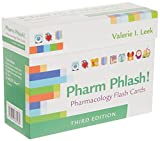
Focus on Pharmacology (8th Edition)
Focus on Nursing Pharmacology makes challenging concepts more approachable. Engaging learning features cultivate your clinical application, critical thinking and patient education capabilities. This updated 8th edition builds on your knowledge of physiology, chemistry and nursing fundamentals to help you conceptualize need-to-know information about each group of drugs.
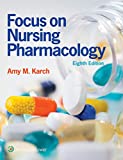
Pharmacology Made Incredibly Easy (Incredibly Easy! Series®)
Nursing pharmacology guide offers step-by-step guidance so you can grasp the fundamentals in enjoyable Incredibly Easy style. This is the perfect supplement to class materials, offering solid preparation for NCLEX® as well as a handy refresher for experienced nurses. Colorfully illustrated chapters offer clear, concise descriptions of crucial nursing pharmacology concepts and procedures.
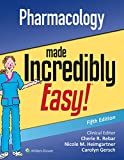
Lehne’s Pharmacology for Nursing Care (11th Edition)
The Eleventh Edition of Lehne’s Pharmacology for Nursing Care provides a thorough understanding of key drugs and their implications for nursing care. This text, written by renowned nursing educators, helps you comprehend and apply pharmacology principles. A clear and engaging writing style simplifies complex concepts, making even the most challenging pharmacology content enjoyable. We recommend this book if you want a comprehensive nursing pharmacology guide.
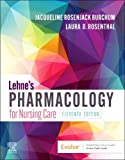
Nursing Drug Handbook
Nursing2023 Drug Handbook delivers evidence-based, nursing-focused drug monographs for nearly 3700 generic, brand-name, and combination drugs. With a tabbed, alphabetical organization and a “New Drugs” section, NDH2023 makes it easy to check drug facts on the spot.
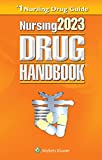
Pharmacology and the Nursing Process
The 10th edition of Pharmacology and the Nursing Process offers practical, user-friendly pharmacology information. The photo atlas contains over 100 unique illustrations and photographs depicting drug administration techniques. Updated drug content reflects the most recent FDA drug approvals, withdrawals, and therapeutic uses.
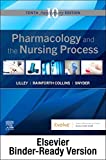
Mosby’s Pharmacology Memory NoteCards: Visual, Mnemonic, and Memory Aids for Nurses
The 6th edition of Mosby’s Pharmacology Memory NoteCards: Visual, Mnemonic, & Memory Aids for Nurses incorporates illustrations and humor to make studying easier and more enjoyable. This unique pharmacology review can be utilized as a spiral-bound notebook or as individual flashcards, making it ideal for mobile study.
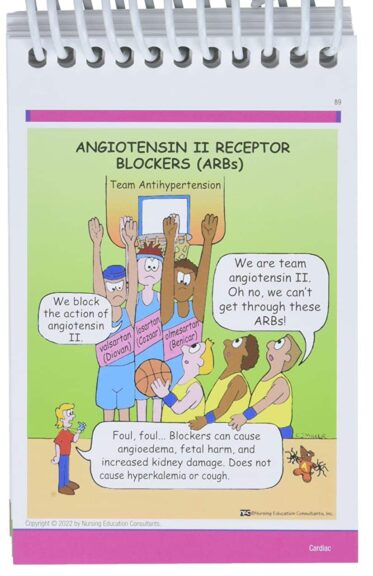
See Also
Here are other nursing pharmacology study guides:
- Nursing Pharmacology – Study Guide for Nurses
Our collection of topics related to nursing pharmacology - Pharmacology Nursing Mnemonics & Tips
These nursing mnemonics aim to simplify the concepts of pharmacology through the use of a simple, concise guide. - Generic Drug Name Stems Cheat Sheet
Learn about these generic drug name stems to help you make sense of drugs easier! - Common Drugs and Their Antidotes
A guide to drug antidotes that nurses should be familiar about. - IV Fluids and Solutions Guide & Cheat Sheet
Get to know the different types of intravenous solutions or IV fluids in this guide and cheat sheet. - Drug Dosage Calculations NCLEX Practice Questions (100+ Items)
Care to take the challenge? This quiz aims to help students and registered nurses alike grasp and master the concepts of medication calculation.
Drug Guides NEW!
Individual drug guides and nursing considerations for the most common medications used in nursing pharmacology:
- Acetaminophen (Tylenol)
- Aspirin
- Atorvastatin (Lipitor)
- Enoxaparin (Lovenox)
- Furosemide (Lasix)
- Gabapentin
- Hydromorphone (Dilaudid)
- Lisinopril
- Metoprolol
- Morphine
Gastrointestinal System Drugs
Respiratory System Drugs
- Antihistamines
- Bronchodilators and Antiasthmatics
- Decongestants
- Expectorants and Mucolytics
- Inhaled Steroids
- Lung Surfactants
Endocrine System Drugs
- Adrenocortical Agents
- Antidiabetic Agents
- Glucose-Elevating Agents
- Hypothalamic Agents
- Insulin
- Parathyroid Agents: Bisphosphonates, Calcitonins
- Pituitary Drugs
- Sulfonylureas
- Thyroid Agents
Autonomic Nervous System Drugs
- Adrenergic Agonists (Sympathomimetics)
- Adrenergic Antagonists (Sympatholytics)
- Anticholinergics (Parasympatholytics)
- Cholinergic Agonists (Parasympathomimetics)
Immune System Drugs
Chemotherapeutic Agents
- Anthelmintics
- Anti-Infective Drugs
- Antibiotics
- Antifungals
- Antineoplastic Agents
- Antiprotozoal Drugs
- Antiviral Drugs
Reproductive System Drugs
Nervous System Drugs
- Antidepressants
- Antiparkinsonism Drugs
- Antiseizure Drugs
- Anxiolytics and Hypnotic Drugs
- General and Local Anesthetics
- Muscle Relaxants
- Narcotics, Narcotic Agonists, and Antimigraine Agents
- Neuromuscular Junction Blocking Agents
- Psychotherapeutic Drugs
Cardiovascular System Drugs
References and Sources
References and sources for this pharmacology guide for drugs affecting coagulation:
- Karch, A. M., & Karch. (2011). Focus on nursing pharmacology. Wolters Kluwer Health/Lippincott Williams & Wilkins. [Link]
- Katzung, B. G. (2017). Basic and clinical pharmacology. McGraw-Hill Education.
- Lehne, R. A., Moore, L. A., Crosby, L. J., & Hamilton, D. B. (2004). Pharmacology for nursing care.
- Smeltzer, S. C., & Bare, B. G. (1992). Brunner & Suddarth’s textbook of medical-surgical nursing. Philadelphia: JB Lippincott.
